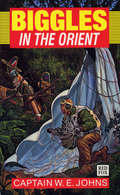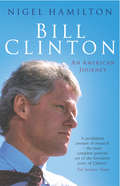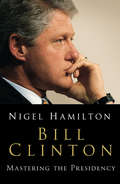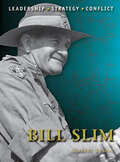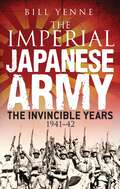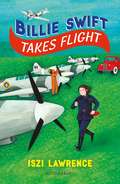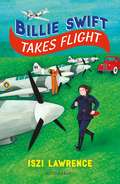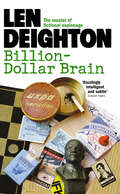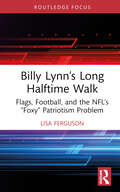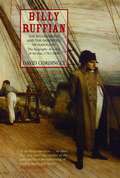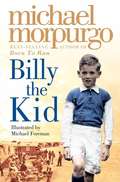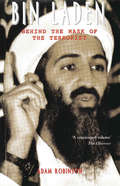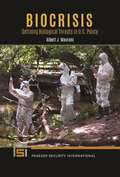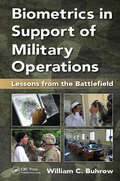- Table View
- List View
Biggles in the Orient
by W E Johns'You're out last hope, Bigglesworth,' said the Air Commodore, with something like despair in his voice.The war supply route between Calcutta and China is a vital one but something is attacking the planes that fly it. Again and again pilots set off, only to disappear somewhere along the line, never to be seen again. When Biggles and his team are called in to investigatem, flying the route is close to a suicide mission . . .
Bildungsangebote zu Nationalsozialismus und Holocaust: Eine empirische Studie zu Reaktionen von Jugendlichen zum pädagogischen Umgang (Holocaust Education – Historisches Lernen – Menschenrechtsbildung)
by Christina UlbrichtChristina Ulbricht untersucht, wie Jugendliche auf unterschiedliche Bildungsangebote zu NS-Verbrechen und Holocaust reagieren. Hierfür befragte sie insgesamt 32 Jugendliche mithilfe leitfadengestützter Interviews zu ihren inner- und außerschulischen Erfahrungen mit diesen Themen sowie zu besuchten Bildungsangeboten. Darüber hinaus hat die Autorin in einem explorativen Vorgehen vor allem Jugendliche aus Bayern in ihrer Auseinandersetzung mit einer KZ-Gedenkstätte beobachtet. Die Auswertung des Datenmaterials mithilfe der ermöglicht unter anderem eine interdisziplinäre Diskussion zur Entwicklung neuer Bildungsangebote, die dem Umstand Rechnung trägt, dass aufgrund der zeitlichen Distanz lediglich mit medialen Verarbeitungen der Überlieferungen von Zeitzeuginnen und Zeitzeugen gearbeitet werden kann.
Bill Clinton: An American Journey
by Nigel HamiltonNigel Hamilton brings all the magisterial authority he brought to his Whitbread-winning biography of Monty, and all the talent for tracking down and verifying hidden, controversial material that he showed in JFK: Reckless Youth, which topped the American bestseller charts for months, in this new biography of Bill Clinton. Born into a 'white trash' family in backwoods, racially segregated Arkansas, he suffered under an alcoholic, violent stepfather, on one occasion having to fight him physically in order to protect his mother. As a youth he would become inspired by the civil rights movement, particularly Martin Luther King, and as a student became a long-haired hippy musician, involved in radical politics and also discovering free love. Hamilton tells the story of how Clinton's sexual and political career developed hand in hand. This is a book about sexual politics on many levels, showing how Clinton's life was formed by changing attitudes. Here is a man who, far from being a sexual predator or exploiter of his position - like JFK - was swept to power because women adored him, whether Democratic party helpers, the women of the American electorate - or indeed Hilary Clinton, whose powerfully manipulative personality is shown to have been vital to his success,. Clinton has been polygamous throughout his adult life, and Hamilton's fascinating portrait of a marriage examines Hilary's relationship with his quite astonishing number of girlfriends. The book also covers his time at Oxford as a Rhodes scholar, his political apprenticeship and his rise to power, culminating in his election as President in '92.
Bill Clinton: Mastering the Presidency
by Nigel HamiltonNigel Hamilton's account of Bill Clinton's early life and career - Bill Clinton: An American Journey - drew widespread praise. Now, in Bill Clinton: Mastering the Presidency, Nigel Hamilton charts the experience of the 42nd President as he took presidential oath of office- and how he fared therafter in the piranha pool of Washington D.C.Hamilton charts what was possibly the greatest disaster and re-reinvention of a president in office in modern times. How Bill Clinton faced up to his failures, and refashioned himself in the White House is an epic story. With a thriving U.S. economy and hard-won wisdom in international affairs and in combating the rise of terrorism, Clinton would begin his second term as the undisputed, immensely popular leader of the Western world - aware, however, that terrors ant treason within America loomed as large as dangers abroad.Insightful, balanced, prodigiously researched and a joy to read, Bill Clinton: Mastering the Presidency is set to become, alongside its prequel, the classic story of Clinton's extraordinary effort to be a modern president, in a modern world-and a chronicle one of the most extraordinary reversals of fortune in modern American politics.
Bill Edrich: The Many Lives of England's Cricket Great
by Leo McKinstryCRICKET LEGEND. WARTIME HERO. FOOTBALL STAR. WILD MAN.'A triumph. Leo McKinstry superbly draws together the many strands of a fascinating but flawed figure' –LAWRENCE BOOTH, WISDEN'Bill Edrich shines through these pages. A wonderful book that needed to be written' – HENRY BLOFELD, OBE'McKinstry's biography will fascinate cricket lovers' – THE TIMESBill Edrich's story is one of cricket victories, explosive controversies, wartime glory and a life lived to the fullest.571 first-class matches from 1934 to 1958. 36,965 runs. 29th on all-time lists. 86 centuries. 479 wickets. Bill Edrich was one of the biggest cricket stars of his time along with Denis Compton and Len Hutton. He was a Wisden Cricketer of the Year in 1940 and played football for Norwich City and Tottenham Hotspur during the 1930s.In the first biography for 30 years, award-winning writer Leo McKinstry recounts Edrich's audacity both as a cricketer and an RAF pilot. Edrich's flying prowess brought him a promotion to Squadron Leader and won him the Distinguished Flying Cross (DFC) after his part in a courageous daylight raid over Cologne in August 1941.The same action-filled intensity applied to his turbulent private life. A man of keen amorous enthusiasms, he was married five times but rarely allowed his ardour to be inhibited by any wedding vows. Equally unrestrained was his fondness for alcohol and partying, though this trait brought him into conflict with both the cricket and the judicial authorities. After one particularly exuberant display of intoxication during a home Test match, he even lost his place in the England team, only to return for the famous Ashes triumph of 1953.A history of cricket victories, explosive controversies, wartime glory and a life lived to the fullest, this compelling biography reveals the story of one of cricketing's greatest characters.
Bill Edrich: The Many Lives of England's Cricket Great
by Leo McKinstryCRICKET LEGEND. WARTIME HERO. FOOTBALL STAR. WILD MAN.'A triumph. Leo McKinstry superbly draws together the many strands of a fascinating but flawed figure' –LAWRENCE BOOTH, WISDEN'Bill Edrich shines through these pages. A wonderful book that needed to be written' – HENRY BLOFELD, OBE'McKinstry's biography will fascinate cricket lovers' – THE TIMESBill Edrich's story is one of cricket victories, explosive controversies, wartime glory and a life lived to the fullest.571 first-class matches from 1934 to 1958. 36,965 runs. 29th on all-time lists. 86 centuries. 479 wickets. Bill Edrich was one of the biggest cricket stars of his time along with Denis Compton and Len Hutton. He was a Wisden Cricketer of the Year in 1940 and played football for Norwich City and Tottenham Hotspur during the 1930s.In the first biography for 30 years, award-winning writer Leo McKinstry recounts Edrich's audacity both as a cricketer and an RAF pilot. Edrich's flying prowess brought him a promotion to Squadron Leader and won him the Distinguished Flying Cross (DFC) after his part in a courageous daylight raid over Cologne in August 1941.The same action-filled intensity applied to his turbulent private life. A man of keen amorous enthusiasms, he was married five times but rarely allowed his ardour to be inhibited by any wedding vows. Equally unrestrained was his fondness for alcohol and partying, though this trait brought him into conflict with both the cricket and the judicial authorities. After one particularly exuberant display of intoxication during a home Test match, he even lost his place in the England team, only to return for the famous Ashes triumph of 1953.A history of cricket victories, explosive controversies, wartime glory and a life lived to the fullest, this compelling biography reveals the story of one of cricketing's greatest characters.
Bill Slim: The Background, Strategies, Tactics And Battlefield Experiences Of The Greatest Commanders Of History (Command #17)
by Robert LymanBill' Slim was one of the greatest British generals of World War II. In a career that stretched from 1914 until 1958, Bill Slim's greatest triumphs came in India and Burma in the long war against the Japanese. Thrust into a desperate situation, he orchestrated the longest retreat in British Army history in the withdrawal from Burma. He then turned on the Japanese in India, shattered their army, and pursued them to destruction. Apart from his great military victories, Slim also left a legacy of training and morale building that endures in the British Army to this day. This book examines both Bill Slim's military career and his place in military history by examining some of his greatest battles and the strategy and tactics that set him apart from his contemporaries.
Bill Yenne the Imperial Japanese Army: The Invincible Years 1941-42
by Bill YenneThe German offensives which crushed Poland in 1939 and swallowed most of Western Europe in less than two months in 1940 have been well documented and heavily studied, however, the overall picture of the remarkable Japanese offensive land campaign in 1941–42 has received less attention. In this fascinating new book, Bill Yenne documents the years when the Imperial Japanese Army (IJA) was conducting its equally unstoppable ground campaign in the Far East, and unlike other books on this subject, he studies the campaign from the Japanese point of view. He reveals how the IJA were able to conquer huge swathes of Southeast Asia in a little over eight weeks after the attack on Pearl Harbor. Using first-hand accounts from Japanese sources, Yenne reveals the tactics and mindset of the IJA during their offensive, detailing the capturing of Manila, the Philippines, Hong Kong, Singapore, Burma, and the Dutch East Indies. Exploring the infrastructure and technical challenges of waging war across such a huge area, Yenne delves into the hardships that faced individual Japanese soldiers in theatre and explains how the Japanese were able to remain undefeated and establish the aura of invincibility that marked their campaign between 1941–42.
Billie Swift Takes Flight
by Iszi LawrenceThe story of WWII starring the brilliant pilots you've never heard of... the women of the Air Transport Auxiliary (ATA) who battled against the odds to get the air force's planes to the front lines. This coming-of-age tale is perfect for fans of Emma Carroll, Michael Morpurgo and Hilary McKay.October, 1942. When twelve-year-old Billie is out exploring with her pet chicken, she sees a plane crash into a field and is left wondering if the pilot even survived. Determined to find out more, Billie finds a way into the ATA – a group of amazing pilots who defy the odds to get planes from the factories to the front lines – and her life changes for ever. Some of the pilots are men who are too old, or too injured for the air force. But many more are women. Intrepid, inspiring women who show Billie what she might grow up to become.With missions including ferrying turkeys over from Ireland and flying unfamiliar, broken planes, Billie is desperate to help. But piloting fighter planes could turn out to be more than she bargained for...
Billie Swift Takes Flight
by Iszi LawrenceThe story of WWII starring the brilliant pilots you've never heard of... the women of the Air Transport Auxiliary (ATA) who battled against the odds to get the air force's planes to the front lines. This coming-of-age tale is perfect for fans of Emma Carroll, Michael Morpurgo and Hilary McKay.October, 1942. When twelve-year-old Billie is out exploring with her pet chicken, she sees a plane crash into a field and is left wondering if the pilot even survived. Determined to find out more, Billie finds a way into the ATA – a group of amazing pilots who defy the odds to get planes from the factories to the front lines – and her life changes for ever. Some of the pilots are men who are too old, or too injured for the air force. But many more are women. Intrepid, inspiring women who show Billie what she might grow up to become.With missions including ferrying turkeys over from Ireland and flying unfamiliar, broken planes, Billie is desperate to help. But piloting fighter planes could turn out to be more than she bargained for...
Billion-Dollar Brain
by Len DeightonThe classic spy thriller of lethal computer-age intrigue and a maniac’s private cold war, featuring the same anonymous narrator and milieu of The IPCRESS File.
Billy Budd and Other Stories (Collins Classics)
by Herman MelvilleHarperCollins is proud to present its new range of best-loved, essential classics.
Billy Lynn’s Long Halftime Walk: Flags, Football, and the NFL’s “Foxy” Patriotism Problem (Routledge Focus on Literature)
by Lisa FergusonThis book examines how the game of football and militarism have historically overlapped due to their shared celebration of strength, might, and besting a clear and definitive foe. Nevertheless, since September 11, a variety of staged patriotic vignettes dominated most NFL broadcasts, giving the once easy and unforced union a stilted feel. That the War on Terror became a fixture of modern- day Super Bowls was easy to portend; what was more difficult to predict was the imprint it would leave on U.S. citizens and American politics. Ben Fountain’s award- winning novel, Billy Lynn’s Long Halftime Walk, reveals what passes for patriotism in a country that has reduced the sober and stark reality of combat to pageantry and production for the crowd back home, leaving our troops to unwittingly play the part of entertainers, destined to be sexualized just like the cheerleaders and dancers so frequently performing alongside them.
Billy Lynn’s Long Halftime Walk: Flags, Football, and the NFL’s “Foxy” Patriotism Problem (Routledge Focus on Literature)
by Lisa FergusonThis book examines how the game of football and militarism have historically overlapped due to their shared celebration of strength, might, and besting a clear and definitive foe. Nevertheless, since September 11, a variety of staged patriotic vignettes dominated most NFL broadcasts, giving the once easy and unforced union a stilted feel. That the War on Terror became a fixture of modern- day Super Bowls was easy to portend; what was more difficult to predict was the imprint it would leave on U.S. citizens and American politics. Ben Fountain’s award- winning novel, Billy Lynn’s Long Halftime Walk, reveals what passes for patriotism in a country that has reduced the sober and stark reality of combat to pageantry and production for the crowd back home, leaving our troops to unwittingly play the part of entertainers, destined to be sexualized just like the cheerleaders and dancers so frequently performing alongside them.
Billy Ruffian: The Bellerophon And The Downfall Of Napoleon
by David CordinglyThis is the story of the Bellerophon, a ship of the line known to her crew as the Billy Ruffian. Under fourteen captains, she played a conspicuous part in three of the most famous of all sea battles: the battle of the Glorious First of June (1794), the opening action against Revolutionary France; the battle of the Nile (1798), which halted Napoleon's eastern expansion from Cairo; and the battle of Trafalgar (1805), which established British naval supremacy for 100 years and during which her captain was shot dead with a musket ball an hour before Nelson was mortally wounded. But her crowning glory came six weeks after the Battle of Waterloo, when the Napoleon, trapped in La Rochelle, surrendered to the captain of the ship that had dogged his steps for more than twenty years.
Billy the Kid (PDF)
by Michael Morpurgo Michael ForemanDiscover the beautiful stories Michael Morpurgo, author of Warhorse and the nation’s favourite storyteller. Billy was a champion soccer star, playing for Chelsea in the 1930s. But that was before war broke out… Billy the Kid is told through the voice of an 80 year old man, who looks back on his life as Chelsea’s champion striker until the outbreak of war in 1939 and on through his subsequent life. Billy joins Chelsea as a football apprentice, rises through the reserves to become a real champion. His passion for football sees him through the war years – even as a prisoner of war he organises a friendly against the Italians – but, having been injured by a mine he cannot play for Chelsea on his return to England. Billy turns to vagrancy and alcohol and for years he wanders up and down the country. He re-settles in London in a derelict house and is befriended by a family who move him to a shed in their garden. He, in turn, helps their son with his football who in his turn becomes a Chelsea player. Billy becomes a Chelsea Pensioner and his 80th birthday is celebrated when Chelsea play at home. A novel for both children and adults which deals with some difficult issues. Michael Morpurgo’s storytelling is superb and this will be a welcome follow up to the previous Morpurgo/Foreman collaboration – Farm Boy.
Bin Laden: Behind the Mask of the Terrorist
by Adam RobinsonA zealous freedom-fighter who has galvanised Islamic fundamentalists worldwide into a fighting force capable of toppling evil western civilisation. A simple man, pious, upstanding and principled; the moral leader of the faithful. This is the image that Osama bin Laden wishes to project to the world. Now, for the first time, Bin Laden: Behind the Mask of the Terrorist blows the lid off the inside story. The first real insight into the life of the renegade phophet of the apocalypse reveals a past laced with prostitutes, hedonism, and lengthy periods of alcohol abuse. Beneath the self-styled propaganda is a hypocrite whose personal mission is nothing less than the destruction of the United States and her allies in the name of Islam. This is the man who deftly manipulates the institutions he claims to despise in order to further his own ends; who condemns depravity while keeping a hand in the opium and heroin trade. With new information provided by members of his family, the book traces the roots of his dicontent, exploring his privileged childhood riven by jealousies and family polotics. It paints the picture of a youth desperately seeking acceptance and a man whose need for attention and adulation set him upon an unbelievable course.
Biocrisis: Defining Biological Threats in U.S. Policy (Praeger Security International)
by Albert J. MauroniThis book examines the recent intersection of national security and public health regarding biological threats to the U.S. populace and proposes improvements to the executive and legislative development of U.S. policy addressing biological threat mitigation.Over the last 20 years, the national security community has engaged with disease-related issues that have traditionally been the scope of public health agencies. The federal government's response has been to create a single national biodefense strategy, which has been largely ineffective in improving conditions due to poor terminology, a lack of leadership, and a failure to assess government programs.Applying a public policy framework, Albert J. Mauroni examines how the government addresses biological threats-including disease prevention, bioterrorism response, military biodefense, biosurety, and agricultural biosecurity and food safety. He proposes a new approach to countering biological threats, arguing that lead agencies should focus on implementing discrete portfolios with annual assessments against clear and achievable objectives.
Biocrisis: Defining Biological Threats in U.S. Policy (Praeger Security International)
by Albert J. MauroniThis book examines the recent intersection of national security and public health regarding biological threats to the U.S. populace and proposes improvements to the executive and legislative development of U.S. policy addressing biological threat mitigation.Over the last 20 years, the national security community has engaged with disease-related issues that have traditionally been the scope of public health agencies. The federal government's response has been to create a single national biodefense strategy, which has been largely ineffective in improving conditions due to poor terminology, a lack of leadership, and a failure to assess government programs.Applying a public policy framework, Albert J. Mauroni examines how the government addresses biological threats-including disease prevention, bioterrorism response, military biodefense, biosurety, and agricultural biosecurity and food safety. He proposes a new approach to countering biological threats, arguing that lead agencies should focus on implementing discrete portfolios with annual assessments against clear and achievable objectives.
Biohazard: The Chilling True Story Of The Largest Covert Biological Weapons Program In The World Told From The Inside By The Man Who Ran It
by Ken Alibek'We thought we had lived through the terror of a nuclear war, but something far more ominous was brewing in the Soviet Union - a biological Armageddon from which no one would escape. Dr Alibek has emerged from the world's deadliest labs to tell a story that is as important as it is chilling. Sometimes the truth is far worse than fiction. No one can afford not to read this book.' Robin Cook 'As the top scientist in the Soviet Union's biowarfare program and the inventor of the world's most powerful anthrax, Dr Ken Alibek has stunned the highest levels of the U.S. government with his revelations. Now, in a calm, compelling, utterly convincing voice, he tells the world what he knows. Modern biology is producing weapons that in killing power may exceed the hydrogen bomb. Ken Alibek describes them with the intimate knowledge of a top weaponeer.' Richard Preston, author of The Hot Zone
Biometrics in Support of Military Operations: Lessons from the Battlefield
by William C. BuhrowBiometrics in Support of Military Operations: Lessons from the Battlefield examines and evaluates recent U.S. military experiences in Iraq and Afghanistan in the context of the use of biometrics and related technologies. The book takes a comprehensive look at how biometrics has been used to support various military operations and suggests ways that its uses can be further developed. It fills a void in understanding how to incorporate biometrics by providing a guide to develop and establish formal operational roles and procedures when applying the technology. Written in an informal style that makes it accessible to people who are not necessarily operators or technicians of biometrics technologies, this book bridges an existing gap to better educate leaders inside and outside of the U.S. military on the far-reaching potential of biometrics in support of tactical operations. It argues that the gap between those inside and outside the military is the result of failure to document lessons learned from battle experience, as well as a lack of a combined vision among the Joint Forces to fully recognize and exploit the capabilities of biometrics for enhanced future success. This book fills that gap. Biometrics has great potential as an effective tool if properly developed and utilized. The book concludes with a look at the future of emerging applications for the military but also considers a wider range of deployment of biometrics outside the military, such as in governmental organizations, including foreign diplomacy. Biometrics can be applied to any operational area that requires accurate and rapid identification of unknown individuals in order to support its operations and protect personnel and resources. Biometrics in Support of Military Operations is an important beginning point in an emerging field for gaining understanding and better mastery of biometrics.
Biometrics in Support of Military Operations: Lessons from the Battlefield
by William C. BuhrowBiometrics in Support of Military Operations: Lessons from the Battlefield examines and evaluates recent U.S. military experiences in Iraq and Afghanistan in the context of the use of biometrics and related technologies. The book takes a comprehensive look at how biometrics has been used to support various military operations and suggests ways that its uses can be further developed. It fills a void in understanding how to incorporate biometrics by providing a guide to develop and establish formal operational roles and procedures when applying the technology. Written in an informal style that makes it accessible to people who are not necessarily operators or technicians of biometrics technologies, this book bridges an existing gap to better educate leaders inside and outside of the U.S. military on the far-reaching potential of biometrics in support of tactical operations. It argues that the gap between those inside and outside the military is the result of failure to document lessons learned from battle experience, as well as a lack of a combined vision among the Joint Forces to fully recognize and exploit the capabilities of biometrics for enhanced future success. This book fills that gap. Biometrics has great potential as an effective tool if properly developed and utilized. The book concludes with a look at the future of emerging applications for the military but also considers a wider range of deployment of biometrics outside the military, such as in governmental organizations, including foreign diplomacy. Biometrics can be applied to any operational area that requires accurate and rapid identification of unknown individuals in order to support its operations and protect personnel and resources. Biometrics in Support of Military Operations is an important beginning point in an emerging field for gaining understanding and better mastery of biometrics.
The Biopolitics of Care in Second World War Britain (The Mass-Observation Critical Series)
by Kimberly MairDuring the crisis of the Second World War in Britain, official Air Raid Precautions made the management of daily life a moral obligation of civil defence by introducing new prescriptions for the care of homes, animals, and persons displaced through evacuation. This book examines how the Mass-Observation movement recorded and shaped the logics of care that became central to those daily routines in homes and neighbourhoods. Kimberly Mair looks at how government publicity campaigns communicated new instructions for care formally, while the circulation of wartime rumours negotiated these instructions informally. These rumours, she argues, explicitly repudiated the improper socialization of evacuees and also produced a salient, but contested, image of the host as a good wartime citizen who was impervious to the cultural invasion of the ostensibly 'animalistic', dirty, and destructive house guest. Mair also considers the explicit contestations over the value of the lives of pets, conceived as animals who do not work with animal caregivers whose use of limited provisions or personal sacrifice could then be judged in the context of wartime hardship. Together, formal and informal instructions for caregiving reshaped everyday habits in the war years to an idealized template of the good citizen committed to the war and nation, with Mass-Observation enacting a watchful form of care by surveilling civilian feeling and habit in the process.
The Biopolitics of Care in Second World War Britain (The Mass-Observation Critical Series)
by Kimberly MairDuring the crisis of the Second World War in Britain, official Air Raid Precautions made the management of daily life a moral obligation of civil defence by introducing new prescriptions for the care of homes, animals, and persons displaced through evacuation. This book examines how the Mass-Observation movement recorded and shaped the logics of care that became central to those daily routines in homes and neighbourhoods. Kimberly Mair looks at how government publicity campaigns communicated new instructions for care formally, while the circulation of wartime rumours negotiated these instructions informally. These rumours, she argues, explicitly repudiated the improper socialization of evacuees and also produced a salient, but contested, image of the host as a good wartime citizen who was impervious to the cultural invasion of the ostensibly 'animalistic', dirty, and destructive house guest. Mair also considers the explicit contestations over the value of the lives of pets, conceived as animals who do not work with animal caregivers whose use of limited provisions or personal sacrifice could then be judged in the context of wartime hardship. Together, formal and informal instructions for caregiving reshaped everyday habits in the war years to an idealized template of the good citizen committed to the war and nation, with Mass-Observation enacting a watchful form of care by surveilling civilian feeling and habit in the process.
Bioterror: Anthrax, Influenza, and the Future of Public Health Security (Praeger Security International)
by R. William JohnstoneThis book uses the 2001 anthrax attacks as its point of departure for an analysis of the past, present, and future of America's preparedness to deal with major challenges to public health, including bioterrorism and pandemic flu. The study identified the strength and weaknesses of the system while making recommendations for improvements. This allows the U.S. to be better prepared if faced with a larger or different biological threat. This book looks for linkages not only between bioterrorists and pandemic defenses, but also between public health security and the wider field of homeland security. Johnstone highlights some key foundation plans and strategies that are to serve as a basis for public health security. Failure to address these crucial issues not only creates unfounded mandates but also inhibits priority setting, leadership, and accountablity.Bioterror: Anthrax, Influenza, and the Future of Public Health Security utilizes a large number of sources from within both the public health and public policy communities to document how each sector responded to the anthrax attacks and re-emergent infectious diseases, and how those responses have evolved to the present day, As with other areas of homeland security, sustained progress in public health security is not likely until basic questions about funding priorities and leadership are successfully addressed. In the response to the only mass casualty event in the United States since 2001, Hurricane Katrina, and in various emergency simulation exercises such as TOPOFF series, major performance deficiencies have been observed. This book brings together a variety of sources, the best available evidence on the status of the public health security system at three distinct points: before 2001; during and immediately after the anthrax attacks; and in the period from 2004 to the present.
